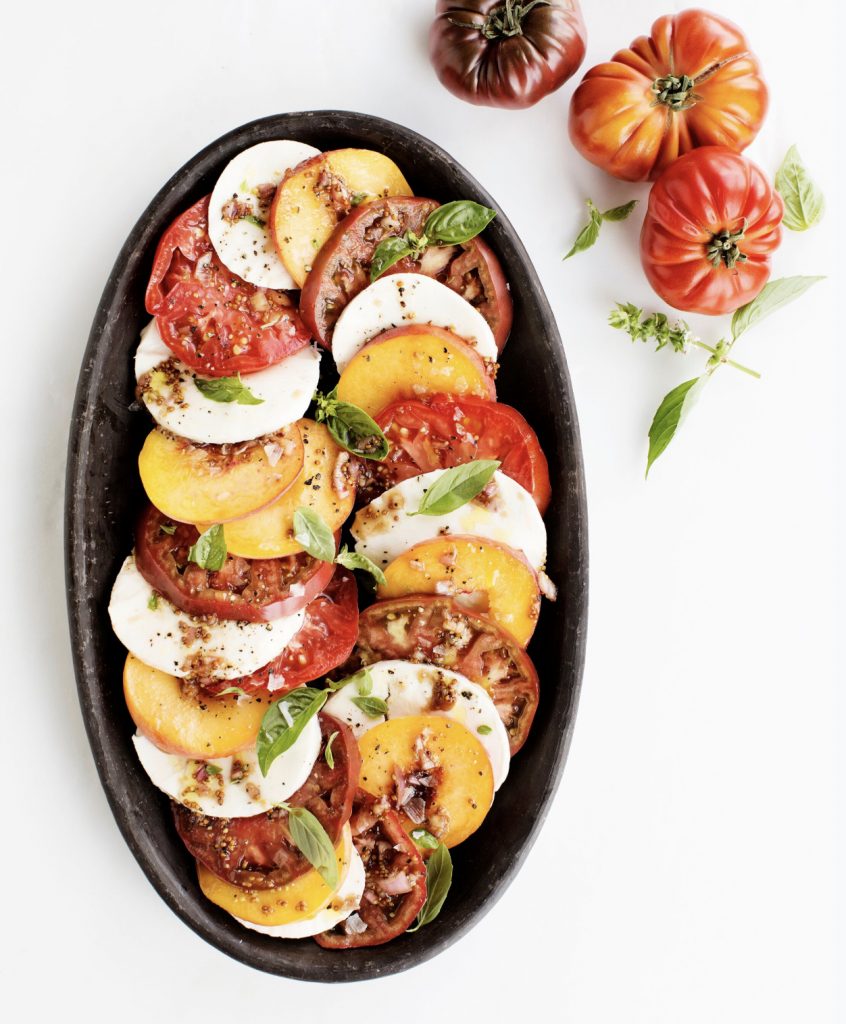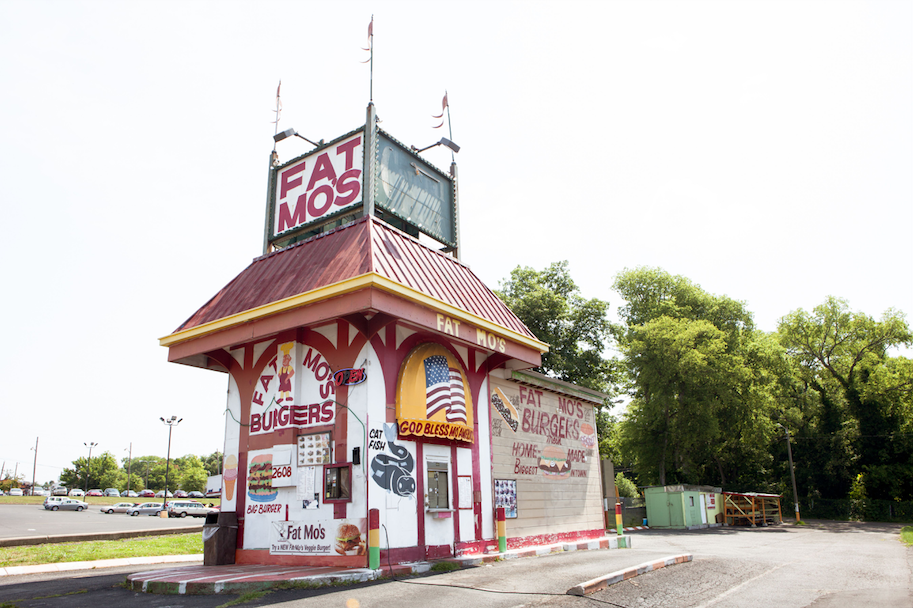
Fat Mo’s is a gastronomic paradox. On the one hand, it’s a fourteen-location, all-American, fast-food chain; on the other hand, it’s a mom-and-pop business whose owners are not American, whose burgers are not cooked in a traditionally American style, and whose service is not particularly fast. It’s a smaller kind of chain, a slower kind of fast food, and an international take on a historically American cuisine. Fat Mo’s defies easy description, partly because of the food they cook and partly because of the people who cook it.
Mohammad and Shiva Karimy are the mom-and-pop owners of Fat Mo’s, what they describe as a “fresh homemade hamburger” chain. When I met them, I casually referred to their business as a fast-food chain, and Shiva quickly corrected me: “We are not fast food; we make everything fresh when you order it.” Point taken. Her distinction isn’t in what they serve, but how they serve it. Fat Mo’s offers a typical fast-food menu (e.g. burgers, sandwiches, fries, shakes); it just takes a couple extra minutes to get it. Surprisingly, this recipe has proven very successful for them. To understand why, you need to experience Fat Mo’s for yourself—and try their burger.
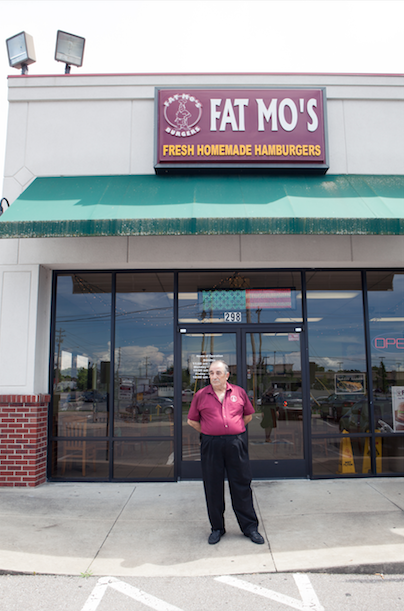
Honestly, I hadn’t been to a Fat Mo’s before I got this assignment. Over the course of writing this story, though, I’ve been an ungodly number of times—let’s just say five times so I don’t sound like a total fat ass. My first experience was at their Smyrna location, which Shiva and Mo recently took over from a struggling franchisee. (Twelve of their fourteen locations were opened by former employees.) When I walked in, Shiva and Mo were standing behind the counter, her in a long dark dress and him in his grease-bespeckled work clothes. It was 1:00 p.m. They shook my hand and, gesturing to the menu, invited me to order lunch.
I scanned the menu from the bottom up, which makes zero sense and made me wonder where all the burgers were. The first items I saw were the “Big Catfish Sandwich,” the “Grilled Chicken Sandwich,” and the “Philly Cheesesteak.” Where are these famous burgers? Oh wait, here they are. About halfway up the menu I saw what I was looking for: half-pound “Double Mo” burger, quarter-pound “Little Mo,” half-pound regular Fat Mo’s burger, 16 oz. Fat Mo’s “Deluxe” burger, and last but not least, the grandaddy of them all, the meat that can’t be beat: the 27 oz. Fat Mo’s “Super Deluxe” burger. Planning to eat again within the next month, I ordered the half-pound regular Fat Mo’s burger and sat down to chat with Shiva.
As I waited for my burger, I guided the conversation toward what I would soon be eating: what makes a Fat Mo’s burger different? Shiva eyes darted around the room in search of Mr. Mo, her husband of thirty years and head chef of twenty-three. “Mo can tell you more, but for one, our burgers are fresh. We make them every day by hand.” She stresses freshness, both on the Fat Mo’s website and when talking to me. At first I feel like I’m being sold to, but when I see their burgers firsthand, I believe her.
Their patties bear the unmistakable, almost-perfection of something handmade. Despite being thinner than the practically meatball-shaped patties you see in newly popular gourmet burger joints, they share a certain something that says they weren’t made by a machine. Shiva explains how every morning she and Mo form them by hand, patting them down with their palms (she shows me her palm) and rounding them off with the L-shaped curve between their index fingers and thumbs (she traces a line from the tip of her index finger to the tip of her thumb).
The fact that Fat Mo’s burgers are fresh doesn’t make them special, though. What makes them special is what Shiva refers to as “the Persian spices and herbs.” She lists out a few of them upon request: cumin, turmeric, oregano. Mo mixes these (along with fifteen other secret seasonings), adds water, and makes a marinade out of them. He uses this marinade not before he cooks the burgers, like most marinades are used, but while he cooks them. He sears the burgers on both sides at 400 degrees, then drops them into the cool marinade bath for two minutes. Then, in an act of beautiful beef torture, he puts the freshly cooled, marinated burgers back on the flat-top for another few minutes to cook them through. There’s no such thing as medium-rare at Fat Mo’s; everything is served well-done.
When I get my burger, well-done, it doesn’t come out looking fancy. It’s served on a red plastic tray along with a handful of spicy fries. It reminds me of the way my hometown soft-serve shack used to serve its burgers. I lift up the sesame bun to inspect what’s inside: ketchup, mustard, mayo, pickles, lettuce, tomato, and of course my burger. Just as I ordered. As I bite into it, the vinegary Heinz ketchup cuts some of the spices Shiva just clued me in on—especially the cumin. The spiciness is subtle, but it makes a Fat Mo’s burger taste different than your average McDonald’s or Burger King burger. It tastes like a burger from a faraway place and a bygone era. Which it is.
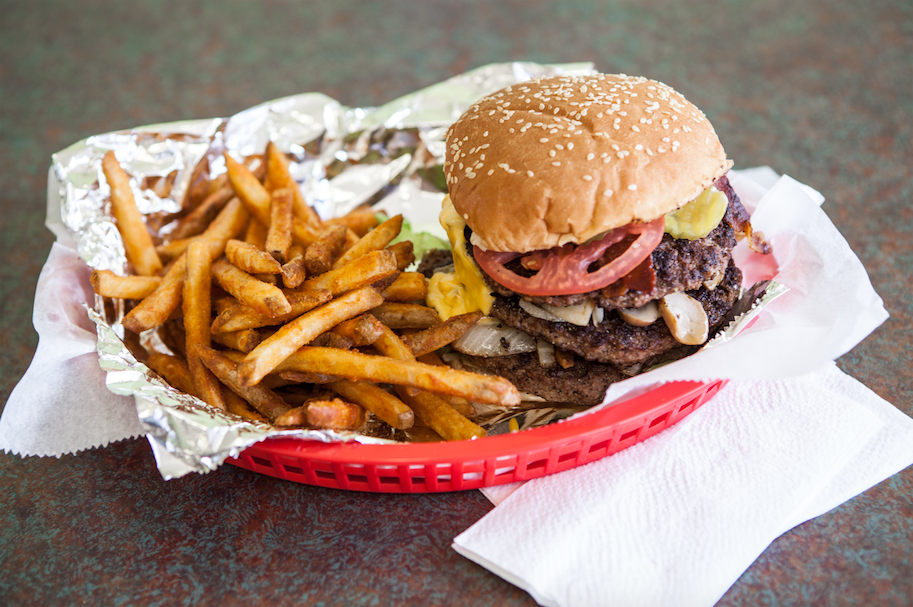
Mohammad learned this recipe when he was a teenager in Iran. Before he worked as an Oriental rug salesman in Vienna, before he met Shiva in Istanbul, and before the Iranian revolution started in 1978, Mo worked at an American-style fast-food restaurant in Tehran. That’s where he picked up the spicy marinade technique that defines a Fat Mo’s burger. The spice mixture, a variation of a traditional Persian advieh, is used in many meat dishes and rice dishes. It’s sometimes added to a stock (like in the case of stews), but it’s frequently turned into a marinade as well. If you’ve had Persian food before, you’ll recognize some of the flavors seared into the outside of Mo’s burger. It’s an Iranian take on an American classic.
The fact that Mo worked at an American-style fast-food restaurant shows how different life was in prerevolutionary Iran. According to Shiva, she and Mo grew up in the “America of the Middle East,” a secular melting pot of immigrants and religions and ideas, many of them Western. She remembers watching Days of Our Lives religiously with her grandmother and going to see The Sound of Music at a big multiplex with her friends. Mo remembers listening to a famous Italian singer named Al Bano and watching him perform on the roof of a hotel in Tehran: “Thousands of people filled the streets around the hotel to see him. They chanted his name.”
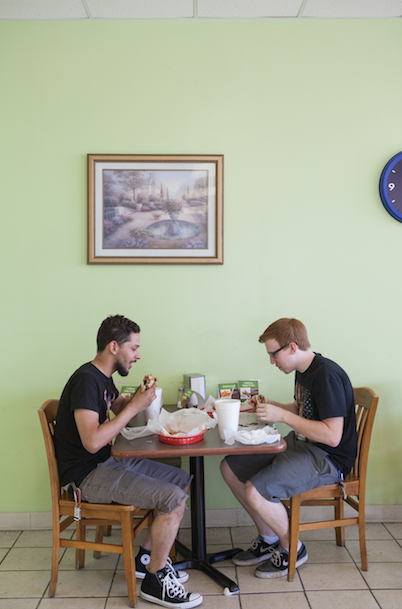
The Iran the Karimys grew up in had many Western influences and had had Western (and Eastern) influences for thousands of years. Iranian food is a product of this influence. Ever since the Silk Road established a channel of cultural transmission between Asia, the Middle East, and Europe, there has been a cross-pollination of ingredients and cooking styles between these regions. We know that Marco Polo famously brought back noodles from China, but many other ingredients were traded as well, such as black pepper and nutmeg. This gastronomic exchange continued throughout the Renaissance and the Enlightenment, as travel between Europe and the Middle East became easier. Over time, French and Italian cooking styles gradually influenced Iranian cooking, and vice versa.
Mo flipping burgers in 1970s Tehran is a modern example of this cultural exchange, one that was aided by Western radio and television. People all over the world saw Americans eating fast food all the time, and it wasn’t long before they combined elements of this traditionally American cuisine with their own. That’s how you end up with homemade Persian-spice-marinated burgers being served in Iran. How those burgers ended up being served in Nashville is another story—one that completes its own circle of cultural exchange.
When the anti-Shah demonstrations turned violent in 1978, many Iranians who could leave the country did. Mo and Shiva were among those people. They moved to two of the more popular places for Iranian refugees at the time. He moved to Vienna, where he sold Persian and Oriental rugs for several years; she went to university in Istanbul, about halfway between Iran and Austria. They met a year later in Istanbul. Shiva was studying to become a doctor like her father, but she decided to marry Mo and leave Istanbul with him. They resettled in Vienna because of Mo’s connections there, but six years later they secured political asylum in the United States, which was hard to get and hard to pass up. As soon as they could, they bought two one-way tickets to Nashville.
For many Iranian immigrants at the time (and basically all immigrants ever), making a living in their new home country proved difficult. They went from being well-respected doctors to taxi drivers, from lawyers to window washers, from CEOs to janitors. For Shiva and Mo, the transition was smoother. They had a skill that was easily transferrable and didn’t require any credentials or graduate degrees (and is probably the most stereotypically American skill next to herding cattle): making burgers.
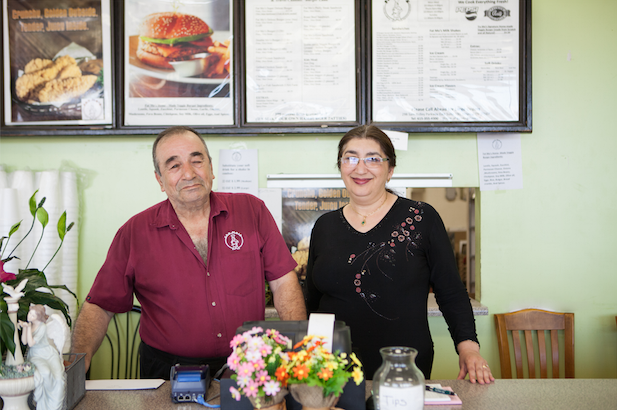
When they opened the original Fat Mo’s in Antioch in 1991, about three years after arriving in Nashville, Shiva and Mo decided to make burgers the way they did in Iran. Unlike their main competition at the time—multinational burger chains like McDonald’s and Burger King—they began serving fresh burgers that were made to order. This is an important point of distinction for Shiva: “We never use lamp heat. No lamp heat, no microwave.” That’s a good thing. That means your food hasn’t been sitting around for half an hour before you eat it. It’s how the big multinational chains used to do it, before they became big multinational chains.
Shiva and Mo also stuck with their tried-and-true spice-marinade recipe. Overall, this process takes longer than their competitors’, but it yields a tastier product. It also yields longer waiting times. Shiva explains, “Our drive-thru got backed up at first, but we devised a more efficient system. We would go out and take orders from the line.” Word to the wise: if you’re getting a burger, it’ll take about five minutes; if you’re getting the catfish sandwich, though, it can take up to ten minutes. The sooner you can get your order in, the better it is for everybody—which is why they let you call in your order before you go and pick it up (hint, hint).
“Everyone thinks Fat Mo burgers are not healthy. Actually, they have a 81/19 meat-to-fat ratio.”
If you haven’t seen a Fat Mo’s menu in a while, you should be ashamed of yourself. But you should also check it out. In an attempt to evolve with the health-conscious times, Shiva and Mo have added some lighter options to the menu. Depending on the franchise, you might see a homemade turkey or veggie burger, made with a similar Persian spice mixture incorporated into the burger itself. On the slightly less healthy side of the equation, you might see a Philly cheesesteak or a fried catfish sandwich. If you want a gyro, they have those too now.
When I ask her if Fat Mo’s is on a diet, Shiva betrays a hint of frustration. “Everyone thinks Fat Mo burgers are not healthy. Actually, they have a 81/19 meat-to-fat ratio.” While this isn’t technically “lean” beef—that requires a 92/8 meat-to-fat ratio—it’s leaner than most burgers you can order. (Chefs often push this ratio closer to 70/30. The more fat your burger has, the better it’ll generally taste.) Knowing this makes me feel better about scarfing down that half-pounder. I grab another handful of spicy fries as Shiva goes into depth about her potato and ice cream distributors.
Talking to Shiva reminds me that food is more than a recipe. It’s a product of the people who make it and the history behind it just as much as the ingredients that go into it. Knowing this information about Fat Mo’s might change the way you experience their food. It might remind you of the 1970s or all the times you watched The Sound of Music. It might bring out flavors from half a world away that you otherwise wouldn’t have noticed, like cumin or turmeric. You might even imagine a young Mohammad Karimy flipping burgers in what was once a secular, prerevolutionary Iran. The next time you bite into a Fat Mo’s burger, think about the story behind Fat Mo’s and how that burger came to be. It might make it taste even better than it already does.
MORE INFO
——————
Fat Mo’s
fatmos.com
Follow on Facebook @fatmos
native.is/fat-mos
Suggested Content
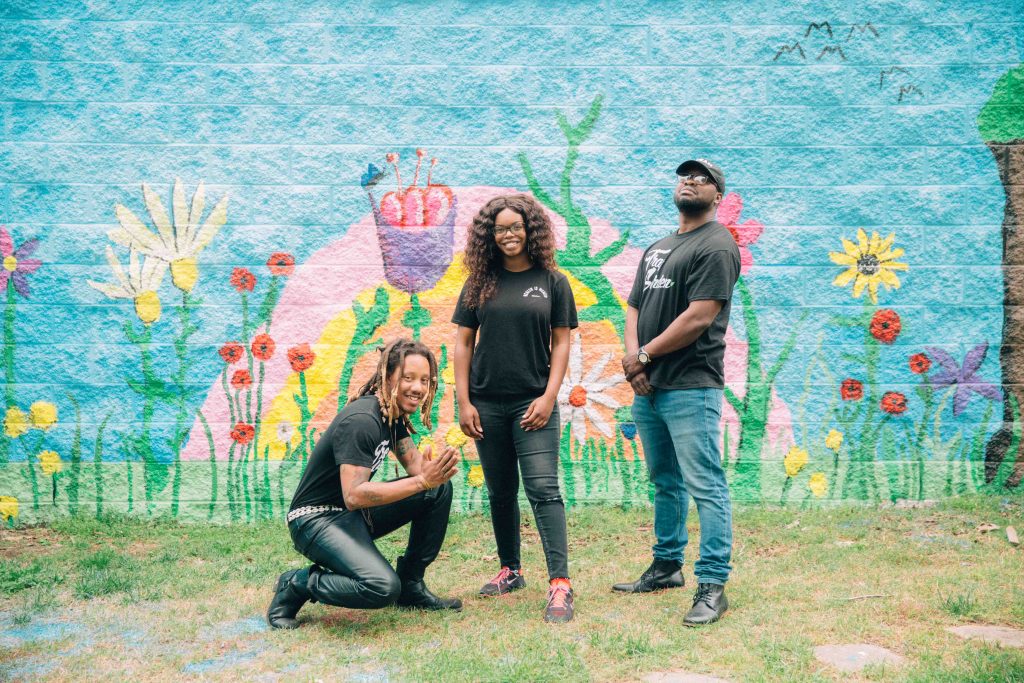
Can You Dig It?
How urban farming nonprofit Trap Garden is working to eradicate Nashville’s food deserts

Double Scoop of Happiness
Kokos Ice Cream creators Jerusa van Lith and Sam Brooker want to show you just how good ice cream can be.

